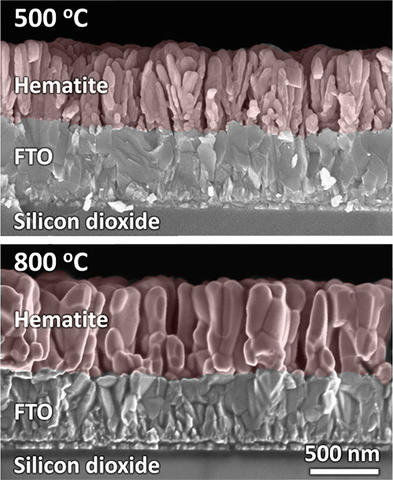
Hydrogen gas that is created using solar energy to split water into hydrogen and oxygen has the potential to be a cost-effective fuel source if the efficiency of the catalysts used in the water-splitting process can be improved. By controlling the placement of key additives (dopant atoms) in an iron oxide catalyst, researchers from the NIST Center for Nanoscale Science and Technology have found that the final location of the dopants and the temperature at which they are incorporated into the catalyst crystal lattice determine overall catalytic performance in splitting water.* The iron oxide hematite is a promising catalyst for water splitting because it is stable in water and absorbs a large portion of the solar spectrum. It is also abundant in the earth's crust, making it inexpensive. Unfortunately, pure hematite has only modest catalytic activity, falling well short of its predicted theoretical maximum efficiency. Incorporating dopants such as tin atoms into hematite's lattice improves performance, but it is a challenge to accurately measure the dopant concentration, making it difficult to understand and optimize their effects on catalyst performance. Using thin films of hematite doped with tin, the researchers produced highly active samples that enabled them to measure and characterize the spatial distribution of dopants in the material and their role in catalysis. The researchers determined that as a result of the sample preparation protocol they followed, a dopant gradient extends from the interface with the dopant source to the catalyst surface, where the measured concentration is low compared with previous estimates from similarly prepared samples. Contrary to prior results, they found that only a small dopant concentration is needed to improve catalytic activity. The researchers believe this study creates a path for improving the rational design of inexpensive catalysts for splitting water using solar energy.
*Effect of tin doping on α-Fe2O3 photoanodes for water splitting, C. D. Bohn, A. K. Agrawal, E. C. Walter, M. D. Vaudin, A. A. Herzing, P. M. Haney, A. A. Talin, and V. A. Szalai, The Journal of Physical Chemistry C 116, 15290–15296 (2012).
NIST Publication Database Journal Web Site

